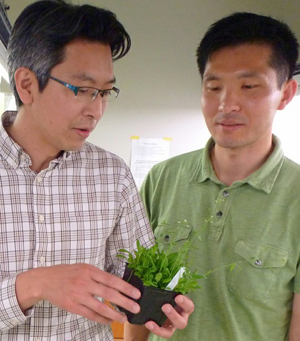Young Hun Song Isolates Flowering Trigger Mechanism
By wchung | 21 Dec, 2025
University of Washington researcher Young Hun Song has figured out how plants know when to flower — a mystery that has tantalized botanists for 80 years.
University of Washington researcher Young Hun Song has figured out how plants know when to flower — a mystery that has tantalized botanists for 80 years.
Once triggered, the mechanism that actually leads to a plant’s flowering is well understood. Once a protein called Flowering Locus T is produced in a plant’s leaves, it travels to the shoot apex. In that part of the plant cells are undifferentiated and can either become leaves or flowers. Once flowering locus T reaches the shoot apex, it sets off molecular changes that cause cells to becom flowers.
What Song and his team wanted to discover was the triggering mechanism that causes plants to begin production of Flowering Locus T protein. Like people and other animals plants were known to possess a circadian clock that controls daily biological processes. To isolate the specific mechanism that lets plants recognize seasonal changes so they can select the right time to begin producing the Flowering Locus T protein, Song’s team zeroed in on the FKF1 protein, a photoreceptor activated by sunlight.
“The FKF1 photoreceptor protein we’ve been working on is expressed in the late afternoon every day, and is very tightly regulated by the plant’s circadian clock,” said Takato Imaizumi, a University of Washington assistant professor who is the study’s corresponding author. “When this protein is expressed during days that are short, this protein cannot be activated, as there is no daylight in the late afternoon. When this protein is expressed during a longer day, this photoreceptor makes use of the light and activates the flowering mechanisms involving Flowering Locus T. The circadian clock regulates the timing of the specific photoreceptor for flowering. That is how plants sense differences in day length.”
This system prevents plants from flowering in winter when days are short and the temperatures aren’t high enough to sustain the plant through its full life cycle.
The study used a small plant in the mustard family called Arabidopsis frequently used in genetic research. A study co-author was Andrew Millar, a professor of biology at the University of Edinburgh who had developed a mathematical model of the mechanism that causes Arabidopsis to flower.
“Our mathematical model helped us to understand the operating principles of the plants’ day-length sensor,” said Millar. “Those principles will hold true in other plants, like rice, where the crop’s day-length response is one of the factors that limits where farmers can obtain good harvests. It’s that same day-length response that needs controlled lighting for laying chickens and fish farms, so it’s just as important to understand this response in animals.
“The proteins involved in animals are not yet so well understood as they are in plants but we expect the same principles that we’ve learned from these studies to apply.”
“If we can regulate the timing of flowering, we might be able to increase crop yield by accelerating or delaying this,” pointed out Imaizumi. “Knowing the mechanism gives us the tools to manipulate this.”
Crops used for biofuels as well as food crops would be prime targets for application of the study’s results.
Young Hun Song is currently a postdoctoral researcher working in the laboratory headed up by Imaizumi at the University of Washington. Song received a BS in Biochemistry in 2000, a masters in biochemistry in 2002 and a PhD in biochemistry in 2007, all from Gyeongsang National University in Korea.
The study’s other co-authors are Benjamin To, who was a UW undergraduate student when the study was being conducted, and Robert Smith, a University of Edinburgh graduate student. Their work was funded by the National Institutes of Health and the United Kingdom’s Biotechnology and Biological Sciences Research Council.
The study was published in the May 25 issue of the journal Science.

University of Washington researcher Song Young Hun has solved a puzzled about plant flowering that has baffled scientists for the past 80 years.
Articles
Asian American Success Stories
- The 130 Most Inspiring Asian Americans of All Time
- 12 Most Brilliant Asian Americans
- Greatest Asian American War Heroes
- Asian American Digital Pioneers
- New Asian American Imagemakers
- Asian American Innovators
- The 20 Most Inspiring Asian Sports Stars
- 5 Most Daring Asian Americans
- Surprising Superstars
- TV’s Hottest Asians
- 100 Greatest Asian American Entrepreneurs
- Asian American Wonder Women
- Greatest Asian American Rags-to-Riches Stories
- Notable Asian American Professionals

